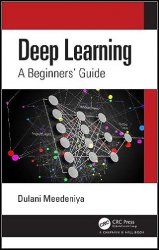 Название: Deep Learning: A Beginners' Guide
Название: Deep Learning: A Beginners' GuideАвтор: Dulani Meedeniya
Издательство: CRC Press
Год: 2024
Страниц: 199
Язык: английский
Формат: pdf (true)
Размер: 23.4 MB
This book focuses on Deep Learning (DL), which is an important aspect of Data Science, that includes predictive modeling. DL applications are widely used in domains such as finance, transport, healthcare, automanufacturing, and advertising. The design of the DL models based on artificial neural networks is influenced by the structure and operation of the brain. This book presents a comprehensive resource for those who seek a solid grasp of the techniques in DL.
Deep Learning (DL) is an important and evolving area in data science that includes statistics and predictive modeling. It is concerned with algorithms inspired by the brain’s structure and functions known as artificial neural networks. DL can automatically learn features in data, by updating learned weights at each layer. This book provides adequate theoretical coverage of DL techniques and applications. This book will teach deep learning concepts from scratch. We aim to make DL approachable by teaching the concepts and theories behind DL models. Thus, practitioners can grab the critical thinking skills required to formulate problems, design and develop models to make accurate predictions and support the decision- making process. Many academic institutions have embarked on DL education and research at various levels. At present, DL has become a forward- looking academic discipline with a wide range of real-world applications.
DL is extremely beneficial to data scientists in collecting, analyzing, and interpreting large amounts of data with efficient processing. There are many advantages associated with Deep Learning. For instance, DL techniques may produce new features from a small collection of features in the training dataset without any further human interaction. The ability to process large numbers of features makes DL techniques very powerful when dealing with unstructured data namely texts, images, and voices. More reliable and concise analysis results can be obtained as the prediction process is based on historical data. In the long run, it also supports improving prediction accuracy by learning from flaws. Although DL techniques can be expensive to train, once trained, it is cost- effective. Moreover, these techniques are scalable, as they can analyze large volumes of data and execute numerous calculations in a cost- and time- effective way.
Key features:
Provides knowledge on theory and design of state-of-the-art deep learning models for real-world applications
Explains the concepts and terminology in problem-solving with deep learning
Explores the theoretical basis for major algorithms and approaches in deep learning
Discusses the enhancement techniques of deep learning models
Identifies the performance evaluation techniques for deep learning models
Accordingly, the book covers the entire process flow of Deep Learning by providing awareness of each of the widely used models. This book can be used as a beginners’ guide where the user can understand the associated concepts and techniques. This book will be a useful resource for undergraduate and postgraduate students, engineers, and researchers, who are starting to learn the subject of Deep Learning.
Скачать Deep Learning: A Beginners' Guide